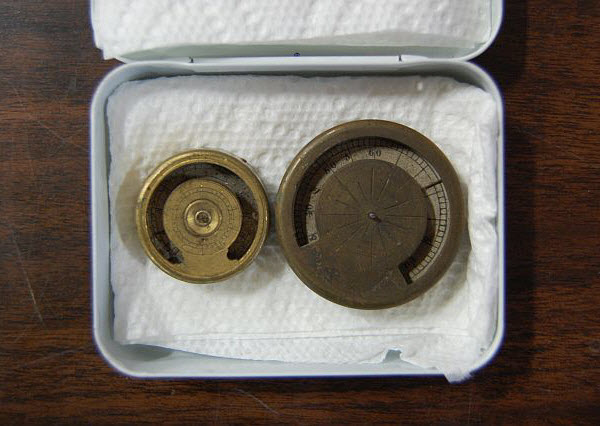Meetings PastNovember 19, 2011 Meeting Highlights
The Chapter's annual holiday meeting took place on Saturday November 19. It was very good to visit with friends old and new among tables at the mart. Members' suggestions for future presentations and workshops were sought and welcomed at this crucial stage of planning for next year’s meetings.
Members congregated at Chapter 148’s November 2011 mart The American Clock & Watch Museum in Bristol, CT is a familiar and nearby resource for chapter members working on repairs, restoration, and research, as well as those looking for information regarding that hard-to-identify horological item. The Museum’s annual gift and book sale took place in November, but a listing of the Museum’s extensive holdings of rare and hard-to-find horological titles may be found year-round on the Museum’s website: www.clockandwatchmuseum.org. Through the efforts of Al and Cheryl Comen, the Chapter's traditional holiday raffle included a selection of truly sumptuous fruit baskets. Cheryl and Al put in much hard work behind-the-scenes over the past year to make our meetings so successful. Special thanks is due them, and to all those who graciously pitched in, for example, to pick up and make refreshments, organize mailings, arrange for speakers, and pack away tables--we really appreciate it! Our best wishes to member Peter Belliveau for speedy recovery from a recent illness. Likewise, we would like to extend our thoughts and most hopeful prayers to Mel and Joan Brown, who are coping with the serious illness of a family member. Member Lydia Rufleth is making remarkable progress in her bid to master the machine shop skills needed to make parts for clock movements. At the meeting Lydia sought and received feedback on her first attempt at making a "dead-center" for a lathe. Sadly we learned that long-time member Helen Smith passed away recently. We will always remember her supportiveness, kindly disposition, and hands that were ready to help. Helen is survived by her husband and chapter member of many years, Mel Smith. She will be greatly missed! The Chapter welcomed Jennifer Carroll, the American Clock & Watch Museum's new executive director. We wish her every success in her endeavors! * * * September 17, 2011 Meeting Highlights The Chapter met on Saturday September 17. Items spotted at our mart included a Seth Thomas miniature alarm timepiece ca. 1890; a German birdcage case clock ca. 1920; Swiss music boxes, and a reproduction jeweler's scale in velvet-lined case. There was also a selection of early 19th century shelf clocks with original reverse glass painted tablets showing historical views, reference books, and a good selection of tools, including custom-made and designed clock makers' tools. Our guest speaker at the September meeting was longtime NAWCC member and clock collector specializing in advertising clocks, Jerry Maltz, a native of the Bronx, NY.
Perhaps no category of clocks reflects American mass-marketing and consumerism in the Gilded Age better than the advertising clocks of the period between 1870 and 1920, which have long captivated Jerry as a collector. Organized around various case and decorative styles as categories of advertising clocks of this period (i.e. desk, novelty, iron, reverse-painted, Baird, etc.), and drawing largely on his superb collection for examples, Jerry introduced us to the pleasures and challenges (including reproductions of various qualities) inherent in collecting advertising clocks. These included researching the clocks' connections with arcane products, and assessing artistic techniques employed in decorating the clocks. Some fascinating and unusual examples of advertising clocks illustrated in Jerry's talk included an iron front clock made by the Regent Clock Co., (likely containing a New Haven Clock Co. movement), advertising the London Dailey News, a Canadian newspaper ca. 1885. Griswold skillets produced in Erie, Pennsylvania between 1865 and 1957 were transformed into advertising clocks, long favorites of members of the Griswold Collectors' Club. Lithographs on tinware decorated clocks advertising Nonesuch mincemeat: the firm of Nonesuch was later acquired by the familiar Smuckers brand. Some clocks illustrated in Jerry's talk exemplified violations of Prohibition; others revealed pricing and quality details of late 19th and early 20th century products. Clocks advertising patent medicines are a particularly interesting and desirable: many examples are found under the Baird and Yale Clock Co. labels. With Jerry's help we traced the transition from horse-drawn vehicles to motor cars through clocks produced by the firm of E.N. Welch, which merged around the turn of the century with the Sessions Clock Co. One of Jerry's favorite references for information about advertising clocks is the book written by Bernie Edwards in 1976. Jerry is himself the author and publisher of the book entitled Baird Advertising Clocks (1998), the definitive source on Baird clocks. Thanks is due to Jerry for a most enjoyable and informative presentation! * * * July 16, 2011 Meeting Highlights Chapter 148 met on Saturday the 16th. We enjoyed visiting fellow members while navigating mart and silent auction tables. We were dismayed to learn that Helen Smith has recently been ill, but pleased to hear she is recovering, and extend our best wishes for speedy healing! We also extend our best wishes to Don Muller, longtime director of the American Clock & Watch Museum. For many years Don has been a fixture at Ch. 148 marts, and we wish him a happy and healthy retirement. We were pleased to find David Follett prowling the mart tables once more, in apparent good health and spirits. Sadly, we learned that longtime NAWCC and chapter member Joseph M. Rodino passed away on May 7. A mason by trade, Joseph was an avid clock collector whose friendly visage will be greatly missed.
The subject of Tom's talk was "Watches for Clock Collectors". During the summer of 2008, expert watch repairer and chapter member Bruce Haynes volunteered to catalog watches in the the American Clock & Watch Museum's collection. Neither he nor the author of this article, then the Museum's curator serving as project scribe, guessed the project would take nearly two years to complete, involve some 3000 watches, and the help of two additional chapter members, Tom Manning and Bill Dunn, as volunteers to meet the not insignificant challenges of readying the Museum's storage spaces and physically organizing a research collection of such breadth. Building on their work, Tom has been able to analyze and interpre the data, and his findings form the basis for his talk. Tom began by saying that at first the study of watches may seem daunting, even to a seasoned clock collector. However, watches are essentially miniature clocks, so with determination it is possible to gain proficiency in inspecting, identifying, and evaluating them. Athough American watchmaking gained momentum some 50 years after mass-production revolutionized the clockmaking industry, its story is no less important or interesting.The key ingredients for success initially lacking were: (1) the technology to make machines to mass produce parts with extremely small tolerances; (2) adequate capital; (3) a less expensive product; and (4) skillful marketing. During the 18th and early 19th centuries, watchmaking in Europe involved some 40 distinct cottage industries. Many American jewelers and clockmakers repaired watches using imported non-interchangeable parts. Meanwhile, a few Eurpeans including Frederick Japy and Pierre Ingold took tentative steps toward mass-production, but their efforts were initially unwelcome in context of the guild tradiiton. Beginning with the early efforts of Luther Goddard and the Pitkins, Tom guided us to the breakthroughs that occurred in the mid-19th century in the Boston area, where technology, capital, and skills came together, and then on to the early competitor watchmaking firms. By the 1870s, American watchmaking had gained the competitive edge through the ready availability of replacement parts. Tom then traced the development of the dollar watch, followed by the industry's rapid demise after WWII. Our thanks to Tom for an enlightening and stimulating presentation! * * * May 21, 2011 Meeting Highlights The chapter's May meeting was held on Saturday morning May 21. If you are looking for something hard to find, chances are sooner or later it will turn up at Chapter 148's mart! For example, at the May mart, a scarce Jeromes & Darrow pillar & scroll shelf clock, in overall fair condition but with intact movement and label, found a new home with collector David Ewbank. A mysterious arbor with four strike wires, apparently once part of a thin-plate wooden movement, attracted attention in a box of miscellaneous parts at Jon Jacobi's table. Finally, a wood movement ogee-style shelf clock bearing the label of Williams, Orton, Prestons & Co., Unionville, Conn., found at Peter Belliveau's table, will yield data for an ongoing research project. The subject of Snowden's presentation was the evolution of the brass shelf clock movement. An apprentice of Eli Terry's, Heman Clark, first produced 30-hr. brass movements based on Terry's 1816 shelf clock patent (the patent included both a wood and brass version), installing them in pillar & scroll cases. Unlike their wooden movement counterparts, these were "high-end" items that became the forerunners of "Salem Bridge" clocks. Next came Joseph Ives' cast brass rack & snail movements ca. 1818. Soon, however, Ives was producing movements made from rolled brass with 6-arbor time and strike trains, but these suffered due to excessive friction within the lengthy trains. Ives' strap brass wagon spring movements, produced in NY ca. 1820 resembled the reliable strap brass A-frame movements produced by C. & L.C. Ives beginning about 1830. John Birge, who was an early member of the firm of C.& L.C. Ives, produced several versions of a rectilinear strap brass movement, but struggled with tooth designs as these did not run well. The firms of Birge, Mallory & Co.; Upson, Merrimans & Co. and P. Barnes & Co. used improved, reliable successors to these movements. About 1835, the firm of Barnes, Bartholomew & Co. began producing nonrolling lantern pinions. Soon the Forestville Manufacturing Co. was pressing plates from rolled sheet brass. Snowden's intense commitment to the study of movements, labels, and primary source documents has yielded many significant contributions to the history of clockmaking. He continues to give graciously and generously of his time by assisting others in identifying, restoring, researching, and writing about antique clocks and clockmaking. Thanks is due to Snowden, and also to the dedicated army of Chapter 148 volunteers who tackled the work that made this meeting a thoroughly enjoyable learning experience! * * * March 19, 2011 Meeting Highlights Chapter 148's March meeting convened on the 19th, a blustery Saturday morning. Piles of snow still ringed the parking lot of Newtown's historic Edmond Town Hall, but did little to dampen the spirits of attendees. Turnout was very good. Navigating the mart, we were often reminded that our members are a truly exceptional lot. Second generation NAWCC member and clock repairer Frank Lyons, Jr. recalled remarkable adventures as small boy assisting his father at shop work, repair rounds, and collecting trips during the 1940s--during which father and son were often accompanied by such early collectors and horological luminaries as Bernard Goldstein (aka "Mr. Barney"), and Paul Dann of New Haven, CT (NAWCC #50). Tom Manning is designing and building a wooden tower timepiece movement in which he plans to install a Harrison-type grasshopper escapement. Bruce Haynes helped beginning repairer and chapter guest Ken Faraci diagnose problems, including a bent roller, badly worn pivots, and a roller table installed backwards, with a ca. 1920 Ingraham pin-pallet balance escapement movement. Richard Hansen has recently written a new book entitled How To Fix Your Own Clock. Copies of this thoughtful and humorous work, more a manual for owners of various types of antique clocks than a shop manual, were spotted for sale at the mart. Our guest speaker was Bob Callaghan. A chance discovery of an antique watchmaker's lathe inscribed with the name of James Bottum led Bob on a quest to learn more about Bottum's enigmatic life and work as an inventor and holder of several horological and related patents during the 3rd quarter of the 19th century. What little was previously known about Bottum appeared in an article by Charles S. Crossman, originally printed in the magazine Jewelers' Circular in the 1880s. Crossman's articles written for the Circular were later published in book form as the Complete History of Watchmaking in America. "Bottum's lathe" was patented in 1850, when its inventor was about 30 years old. Oddly enough, this invention was not really a lathe, but rather a shellac-based wax laced with elemental mercury used to hold work fast to the chuck. Bottum leased his invention, collecting a fee based on how many parts were produced and how much money was thereby saved using the device--an early form of franchise agreement. Bottom was referred to as "eccentric", possibly a manifestation of what are now known to be the effects of exposure to mercury vapor. Besides the "lathe", Bottum's inventions included a hairspring gage. At this point in the program, chapter member Chris Brooks produced an example of Bottum's patent hairspring gage from his own collection, as well as a similar, but unidentified gage, probably not one of Bottum's, since, according to Bob, Bottum's work was typically signed (see photo).
[The two hairspring gages referred to above are both from chapter member Chris Brooks' collection, and both date ca. the 3rd quarter of the 19th century. The larger one on the right is signed by James Bottum. The smaller one on the left is unidentified.] While piecing together Bottom's story, Bob has encountered some puzzling ambiguities in the sources, and some data gaps remain. He shared with the audience valuable insights into the world of primary research, including advising that all information in secondary sources be thoroughly vetted early in the research process so as to avoid perpetuating any errors or misconceptions. Our thanks to Bob and all the others whose gracious efforts made our meeting an enjoyable and stimulating one. * * * Meetings In 2010 |
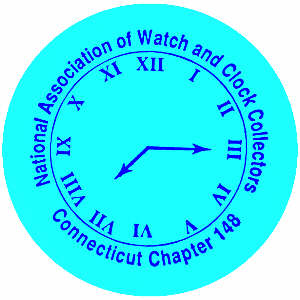
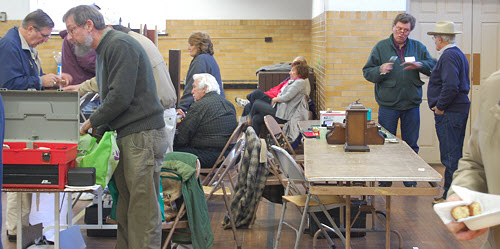
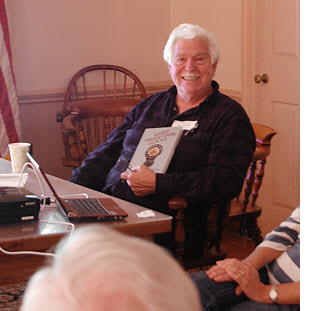 Clocks and watches in private and museum collections connect us with history. As a result of early, catalytic events that took place in Connecticut, our nation emerged during the 19th century as a world leader in manufacturing technology. After the Civil War, about seven relatively large, well-capitalized firms dominated the clock industry. Late 19th century efficiencies resulted in generally large numbers of a few movement models, which were placed in a great variety of case styles.
Clocks and watches in private and museum collections connect us with history. As a result of early, catalytic events that took place in Connecticut, our nation emerged during the 19th century as a world leader in manufacturing technology. After the Civil War, about seven relatively large, well-capitalized firms dominated the clock industry. Late 19th century efficiencies resulted in generally large numbers of a few movement models, which were placed in a great variety of case styles.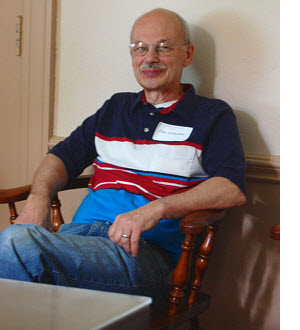 Our guest speaker was longtime collector, restorer, researcher, and lecturer, Tom Grimshaw. Tom, a past director, board and committee member of the American Clock & Watch Museum, is presently the Museum's part-time curator--a position for which he is eminently well qualified and suited.
Our guest speaker was longtime collector, restorer, researcher, and lecturer, Tom Grimshaw. Tom, a past director, board and committee member of the American Clock & Watch Museum, is presently the Museum's part-time curator--a position for which he is eminently well qualified and suited.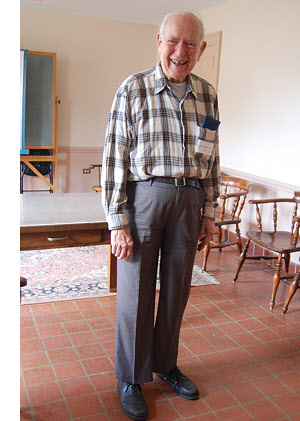 Our guest speaker was author and scholar Snowden Taylor, FNAWCC. Samples of Snowden's many contributions to the science and history of horology are found in the following publications: The Developmental Era of Eli Terry and Seth Thomas Shelf Clocks (1985); Keys to Noble Jerome Patent 30-hr. Brass and Related Weight-Driven Movements (Bulletin No. 221, Part II, 1982); Keys to Identifying Terry-type 30-hr. Wooden Movements (Bulletin No. 208, 1980). Together with the late Kenneth Roberts, Snowden co-authored the 2nd edition of the book entitled Eli Terry and the Connecticut Shelf Clock (1994). Together with Bryan Rogers, he co-authored Eight Day Wood Movement Shelf Clocks-Their Cases, Their Movements, Their Makers (1993). He is also the long-time editor of the Bulletin's popular column "Research Activities & News".
Our guest speaker was author and scholar Snowden Taylor, FNAWCC. Samples of Snowden's many contributions to the science and history of horology are found in the following publications: The Developmental Era of Eli Terry and Seth Thomas Shelf Clocks (1985); Keys to Noble Jerome Patent 30-hr. Brass and Related Weight-Driven Movements (Bulletin No. 221, Part II, 1982); Keys to Identifying Terry-type 30-hr. Wooden Movements (Bulletin No. 208, 1980). Together with the late Kenneth Roberts, Snowden co-authored the 2nd edition of the book entitled Eli Terry and the Connecticut Shelf Clock (1994). Together with Bryan Rogers, he co-authored Eight Day Wood Movement Shelf Clocks-Their Cases, Their Movements, Their Makers (1993). He is also the long-time editor of the Bulletin's popular column "Research Activities & News".